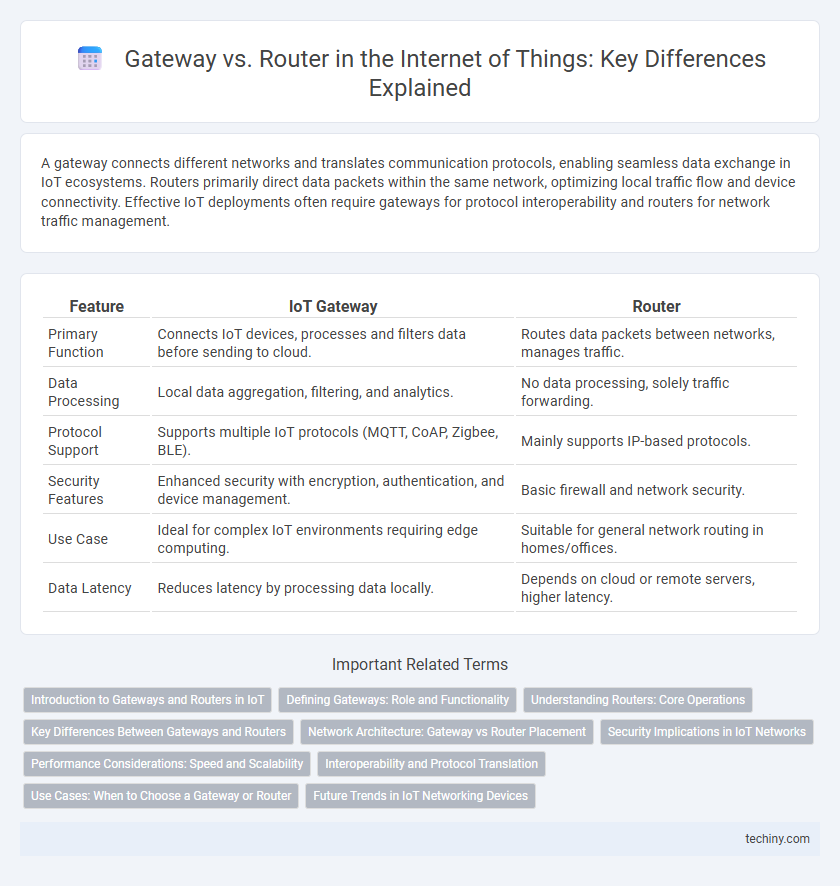A gateway connects different networks and translates communication protocols, enabling seamless data exchange in IoT ecosystems. Routers primarily direct data packets within the same network, optimizing local traffic flow and device connectivity. Effective IoT deployments often require gateways for protocol interoperability and routers for network traffic management.
Table of Comparison
| Feature | IoT Gateway | Router |
|---|---|---|
| Primary Function | Connects IoT devices, processes and filters data before sending to cloud. | Routes data packets between networks, manages traffic. |
| Data Processing | Local data aggregation, filtering, and analytics. | No data processing, solely traffic forwarding. |
| Protocol Support | Supports multiple IoT protocols (MQTT, CoAP, Zigbee, BLE). | Mainly supports IP-based protocols. |
| Security Features | Enhanced security with encryption, authentication, and device management. | Basic firewall and network security. |
| Use Case | Ideal for complex IoT environments requiring edge computing. | Suitable for general network routing in homes/offices. |
| Data Latency | Reduces latency by processing data locally. | Depends on cloud or remote servers, higher latency. |
Introduction to Gateways and Routers in IoT
Gateways in IoT act as critical bridges that connect IoT devices and networks, enabling seamless data transmission across diverse protocols and platforms. Routers specifically direct data packets within networks, managing traffic and ensuring efficient communication between devices in local and wide area networks. Understanding their distinct roles enhances IoT infrastructure by optimizing connectivity, security, and data flow management.
Defining Gateways: Role and Functionality
Gateways in the Internet of Things (IoT) serve as critical intermediaries that connect diverse IoT devices to external networks, enabling seamless communication across heterogeneous protocols. Unlike routers that primarily focus on directing data packets within networks, gateways perform data translation, protocol conversion, and security enforcement, ensuring compatibility and secure data exchange between IoT devices and cloud services. Their role is essential in managing device interoperability, data filtering, and reducing latency in complex IoT ecosystems.
Understanding Routers: Core Operations
Routers operate by directing data packets between different networks using IP addresses, ensuring efficient data transmission and network traffic management. They create and maintain routing tables that determine the optimal path for data, enabling seamless communication in IoT ecosystems. Routers also provide network address translation (NAT) and firewall functions to enhance security within interconnected IoT devices.
Key Differences Between Gateways and Routers
Gateways serve as protocol translators enabling communication between different IoT networks, whereas routers primarily direct data packets within the same network. Gateways perform data filtering, protocol conversion, and security functions, while routers focus on managing data traffic by determining the optimal path for packets. In IoT architecture, gateways handle diverse device interoperability, contrasting with routers that maintain efficient network routing and connectivity.
Network Architecture: Gateway vs Router Placement
In Internet of Things (IoT) network architecture, gateways are typically positioned at the edge between local device networks and external cloud services, enabling protocol translation and data processing. Routers are placed within local area networks to direct data packets between connected devices and maintain efficient internal communication. Proper placement of gateways and routers ensures optimized data flow, network security, and scalable IoT deployment.
Security Implications in IoT Networks
Gateways in IoT networks provide enhanced security by managing data encryption, protocol translation, and device authentication, which helps isolate and protect connected devices from external threats. Routers primarily focus on directing traffic and generally lack the advanced security features necessary to counter IoT-specific vulnerabilities, making them less effective in safeguarding device communication. Implementing gateways with robust security protocols significantly reduces risks such as unauthorized access, data breaches, and malware propagation within IoT environments.
Performance Considerations: Speed and Scalability
Gateways in Internet of Things (IoT) environments typically offer higher scalability by managing diverse protocols and aggregating data from numerous devices, ensuring efficient communication and processing at the edge. Routers prioritize speed and direct data packet forwarding but may face limitations in handling large-scale IoT networks due to protocol incompatibility and lower processing capabilities. Optimizing performance in IoT requires selecting gateways for expansive, heterogeneous device ecosystems and routers for localized, high-speed network traffic.
Interoperability and Protocol Translation
Gateways enable seamless interoperability in IoT ecosystems by translating diverse communication protocols such as MQTT, CoAP, and Zigbee into a unified format that routers cannot process directly. Routers primarily manage data traffic within IP-based networks without protocol conversion, limiting their role in heterogeneous device communication. Effective IoT deployment relies on gateways for protocol translation to connect various sensor networks and cloud platforms, ensuring comprehensive device integration.
Use Cases: When to Choose a Gateway or Router
Gateways excel in IoT scenarios requiring protocol translation, data filtering, and edge computing, making them ideal for industrial automation and smart city applications. Routers are best suited for straightforward network connectivity tasks in home automation and small office environments where simple data routing suffices. Selecting a gateway or router depends on the complexity of the IoT deployment, the need for data processing at the edge, and the types of connected devices.
Future Trends in IoT Networking Devices
Future trends in IoT networking devices highlight gateways evolving with advanced edge computing capabilities to process data locally, reducing latency and enhancing security. Routers are increasingly integrating AI-driven traffic management to optimize network efficiency and support the growing number of connected IoT endpoints. The convergence of gateway and router functionalities is driving more intelligent, adaptive, and scalable IoT network infrastructures.
Gateway vs Router Infographic

 techiny.com
techiny.com